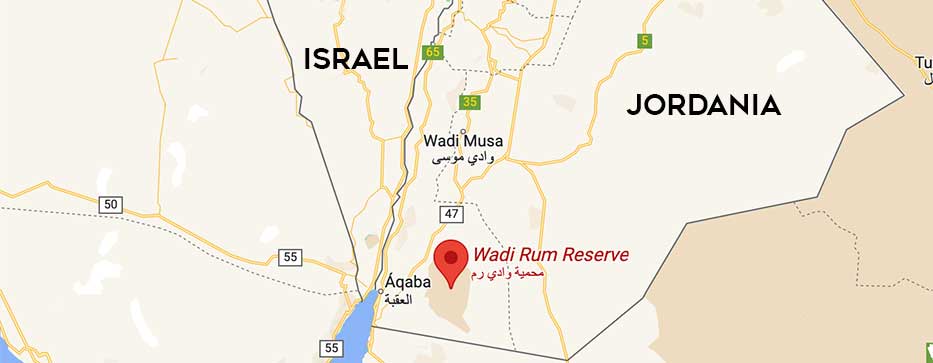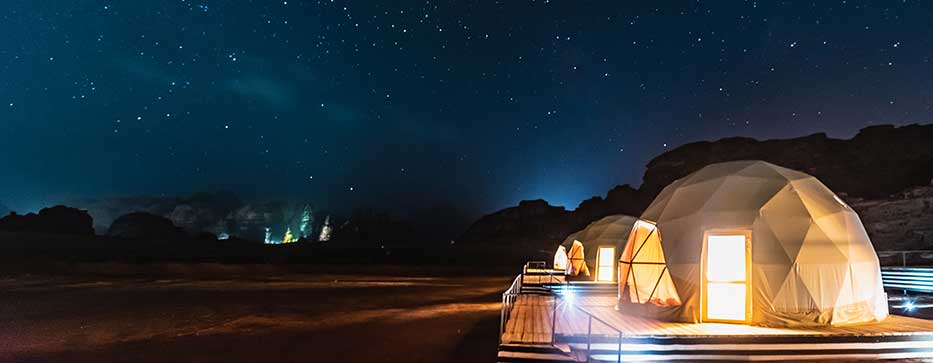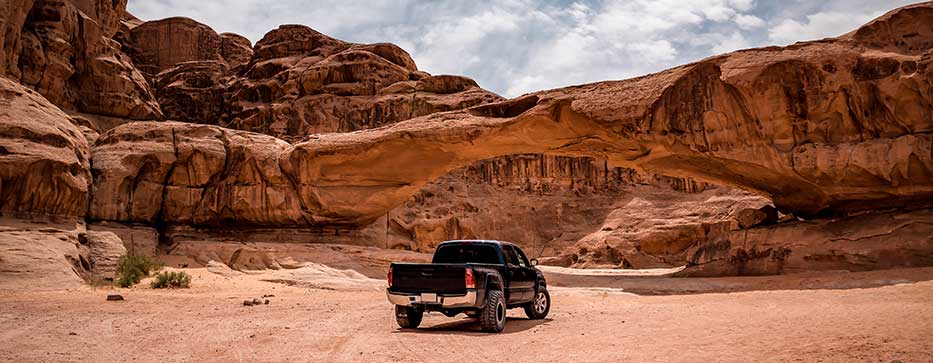Together with Petra, Wadi Rum it is probably the most magnetistic destination in Jordan, the one that attracts the most tourists every year. And no wonder: it is a portion of desert that offers everything a traveler can expect: golden sand dunes, rock formations of spectacular beauty, services for adventure activities and much more. On this page we tell you in depth what to see in Wadi Rum, what is its history, how to get here and, most importantly: what to do in Wadi Rum to enjoy an unforgettable experience.
Wadi Rum is a protected nature reserve located in southern Jordan, within the territory of the Aqaba governorate. In fact, that is the most important city in its surroundings, about 60 km from what is considered its ‘gateway’: Shakaria. However, its central point is considered the village of Wadi Rum, often written as Wadi Rum Village, about 70 km from Aqaba and where the paved road ends. About 7 km before reaching that town is the Visitor Center, a must, where tickets are also taken.
It has an area of about 720 km2 (72,000 hectares), so its space is really large and unfathomable on foot. The translation of its name in Aramaic is “high valley” or “elevated valley”, which helps us understand one of its geographical characteristics: its high altitude, at about 1,600 meters above sea level. Its highest point is Jbel um ad Dami, at more than 1,850 meters above sea level.
This, together with its latitude, its very low rainfall regime and other conditions such as its great insolation, leaves us with a typical desert climate: really scorching temperatures during the day in the warm months, to descend sharply at night, becoming absolutely freezing in winter. Therefore, in summer it is essential to have adequate protection against the sun and heat (water, sunscreen, sunglasses, etc.) and in winter it is essential to have thermal clothing and coat, including gloves and hat.
However, there is one particular feature worth highlighting: the existence of siqs or rocky canyons creates shaded areas, in some cases throughout the day, functioning as authentic microclimatic islands where you can rest from the heat and enjoy the view, as they allow the emergence of an almost miraculous flora of shrubs and trees that seem to grow directly from the rock.

Although today it seems a really hostile place for life, where only the courage of the Bedouin people makes them survive, Wadi Rum It was actually a much more human-friendly place from an environmental and climate point of view. And proof of this is the rich history behind it.
Millennia ago, it was an area rich in springs and wells, and in fact the Greeks and Romans spoke of its pine forests, vineyards and olive groves, now disappeared but which allow the visitor to get an idea of how different the landscape was here.
But the best sign, never better said, of the civilizations that lived here or paraded are their petroglyphs (drawings engraved on the stone) and inscriptions on the rock. It is estimated that there are about 30,000, some of which are most fascinating. The first tribes to do so probably came from Arabia, known as Zamudis, who made inscriptions in the Zamudic language, and the Nabataeans took the baton: this people, who had their ‘capital’ in Petra, left here testimonies of their worship of divinities such as Dushara and Allat.
There are also numerous burial mounds in Wadi Rum, indicating that this was not simply a place of passage, but that there were permanent and stable settlements. In addition, the importance of hunting in this nature reserve is demonstrated, as well as the extraction of minerals in the time of King Solomon, for example.
With the passage of centuries and the sharpening of its extreme climate, this place came under the management of the Bedouin tribes, the only ones that have proven capable of surviving in such a harsh environment. They always did it with their nomadic lifestyle, although today they have opted for a more stable and sedentary way, as evidenced by the establishment of some families in the village of Wadi Rum.
But without a doubt, Wadi Rum is so famous today thanks to the ‘promo’ of one of the most successful films in Hollywood: Lawrence of Arabia. The film narrates the participation of Thomas Edward Lawrence in the Arab Rebellion of 1917, a key character in that historical episode for Jordan, although he may have been disproportionately exalted to take advantage of his media and tourist pull.
Be that as it may, this British archaeologist, writer and soldier soon joined the cause promoted by King Hussein bin Ali, whose great aspiration was to create an Arab state independent of the Ottoman Empire. He fought in the armies of Emir Faysal and felt one more (and dressed as such) of that epic that is considered the germ of the later Arab state of Jordan.
His great contribution was, in fact, the book The Seven Pillars of Wisdom. : although it is an autobiography, it served to make known in the West the ins and outs of the Arab Rebellion. And in some passages of the work are described places of Wadi Rum, who have helped forever unite the name of Thomas Edward Lawrence with this nature reserve.

Contrary to what you might think, there is a lot to see in Wadi Rum. Despite being a desert, the rich history of this place means that there are also corners worth visiting from an archaeological, artistic and ethnological point of view. Not surprisingly, this place was declared a World Heritage Site by UNESCO in 2011.
Most things to see in Wadi Rum They are natural, especially geological, as they are like whimsical formations in granite and sandstone. But there are also man-made ‘works’ worth dwelling on. We group them according to their theme:

As you can imagine, there is not only a lot to see in Wadi Rum: there is also a lot What to do. Wadi Rum It is a space with an extraordinary variety of experiences to make you feel in harmony with this overwhelming but welcoming space at the same time.
Some proposals require a special physical form, since they are adventure sports, but in other cases they are suitable for all types of travelers. This is a list of proposals what to do in Wadi Rum, very popular among its visitors.

Tourism has put Wadi Rum on the front page, so it is easy to get here with private transport from other parts of the country, despite the very small number of inhabitants who live in this place and its surroundings.
For those who want to get to Wadi Rum as soon as possible from another country, the fastest is to fly to Aqaba: this Jordanian city located on the shores of the Red Sea has its own international airport, mainly with charter and seasonal flights, and is about 75 km from Wadi Rum Village, which is about an hour’s drive. Aqaba, by the way, can also be reached by boat: by private catamarans from Taba and by ferry from Nuweiba, both cities in Egypt’s Sinai Peninsula.
Many more air routes, especially regular ones, offer the Queen Alia International Airport of Amman, although its distance from this nature reserve is much greater: almost 300 km, which is about 3 and a half hours by road. This is a list of places, distances and routes that will serve as an orientation if you are going to schedule your trip on your own:
As far as public transport is concerned, the only viable option is the bus: JETT includes Wadi Rum in its route network, connecting it with Petra (Wadi Musa) and Aqaba. Beyond that, an independent traveler can only arrange a taxi from Aqaba.
Minibuses leaving Aqaba and heading north on the Desert Road and King’s Roads do not usually reach the heart of the Wadi Rum reserve, but simply stop at the Rashidiyah junction.
As we have said before, there is a train station in Wadi Rum, but the trains that are parked there are only locomotives and museum cars: they do not transport passengers, they do not even move to carry goods.
In Wadi Rum There is a modern visitor center that is multifaceted: here you can buy the ticket to access the nature reserve, receive information, arrange excursions, manage accommodation in the reserve, hire guides, eat in its restaurant, buy local crafts in its shop or visit its museum, which includes a small cinema where a documentary is projected. It also has public toilets.
A few kilometers before reaching this point, in Shakaria, is the police station that serves the area. Meanwhile, the nearest petrol station is outside the perimeter of the nature reserve, on the road linking Shakaria to Disah.





